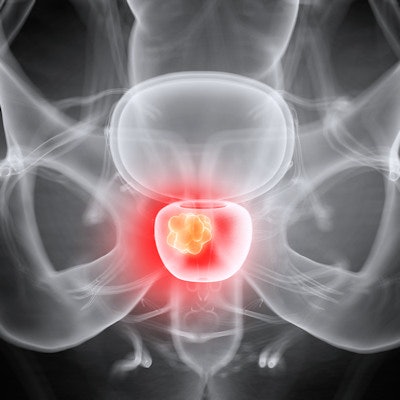
Adding F-18 choline PET to multiparametric MRI (mpMRI) was more effective than mpMRI alone in determining which men with elevated prostate-specific antigen (PSA) levels should go on to biopsy in a new study, published online July 26 in the Journal of Nuclear Medicine.
Researchers evaluated nine different screening scenarios and found that choline-PET/mpMRI combined with Likert scores of 4 or 5 to characterize lesions was the most cost-effective strategy and helped to greatly reduce the number of unwarranted biopsies, compared with mpMRI alone.
"The increased accuracy of hybrid F-18 choline PET/mpMRI leads to better stratification of who should receive biopsy, which enables avoidance of unneeded biopsy in approximately 35% when compared to using mpMRI alone," wrote lead author Christine Barnett, PhD, senior research health economist with RTI Health Solutions, and colleagues from the University of Michigan. "This contributes sufficient health benefits in terms of quality-adjusted life years (QALYs) to justify the added cost based on standard estimates of willingness to pay in the U.S."
Early prostate cancer detection based on PSA screening has its flaws, with previous studies citing poor sensitivity and specificity, which can lead to incorrect diagnosis and misguided treatment. To improve detection, some clinicians have opted for mpMRI and its improved sensitivity and specificity, especially in patients with Gleason scores of 3 and 4.
A 2016 prospective trial by Montgomery et al found that adding choline-PET to mpMRI significantly improved diagnostic accuracy in this patient population and reduced false positives for intermediate-risk lesions detected on mpMRI, the authors noted in their study.
One question, however, remains: Is choline-PET/mpMRI cost-effective?
To put some financial perspective to satisfactory patient outcomes, Barnett and colleagues adapted an mpMRI outcomes/economics model that simulated the onset and progression of prostate cancer in men 40 years and older until the end of their life. For this study, the model stratified men with elevated PSA levels and Gleason scores of 3 and 4 who underwent choline-PET/mpMRI scans prior to a biopsy.
The researchers then analyzed nine different screening strategies for biopsy-naïve men who were screened every two years from ages 55 to 69, according to the American Urological Association (AUA) guidelines. The first approach included standard biopsy for all patients with elevated PSA levels greater than 4 ng/mL, while the other eight strategies recommended variations of mpMRI with or without choline-PET for patients with the same high PSA levels.
Differences in costs and QALYs also were calculated for each scenario. Since there is no reimbursement for PET/MRI, the researchers estimated the cost for a prostate scan using Medicare's FDG-PET/CT payment of $1,414.
"Applying the costs for F-18 FDG is justified because the production costs for F-18 choline and F-18 FDG are similar," they explained. "The Medicare cost for prostate mpMRI without gadolinium-containing contrast material is $964.21."
Although choline-PET/mpMRI is more expensive than mpMRI alone by $449.92, the hybrid modality was more cost-effective in a number of screening scenarios. The best strategy was performed with the hybrid modality and patients with a Likert score of 4 or 5, which resulted in a cost of $22,706 per QALY. Cost-effectiveness also was improved through standard and targeted biopsy for men with positive image results and by omitting biopsies for men with negative imaging results.




















